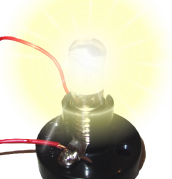What is Photonics?
That is probably the question you are asking right now - just what is photonics? Well, you have come to the right place.
Photonics is the transmission, control, manipulation and storage of data using photons (the basic building blocks of light). Humans have been using light to transmit information for centuries. The first optical networks consisted of fires lit on hill tops to warn the approach of an army. A few centuries later, networks of semiphores were built to convey more complicated messages. Today, optical networks are much faster, more efficient and can go further.
Just how is the light transmitted?
The light is transmitted through optical fibres using lasers. Just one of these optical fibres can carry the equivalent of 300,000,000 simultaneous phone calls or on a more practical level, around 40,000.
Cities and countries across the world can now be linked together and have the capacity to transmit information to one another at high speed.
Many different streams of information can be sent down the same optical fibre by using different wavelengths of light, much the same as using different radio frequencies to broadcast multiple television and radio stations through the air.
What is Photonics Used For?
Photonic devices have the potential to increase the capacity of existing optical fibre cable networks by 500 times for a relativly small cost.
For example using electronic repeaters a 1000km optical fibre link between Sydney and Brisbane needs 25 repeaters and has a maximum capacity of 150 Mb.
The same fibre link using optical amplifiers instead of electronic repeaters only needs 9 amplifiers and has a total capacity in excess of 75,000 Mb.
Photonic technology has many applications in the following areas:
Telephone
Underwater Optical fibres cables can be used to link countries together allowing them to communicate via the telephone. These opical fibre cables have the capacity to transmit many thousands of similtanous phone calls between many different countries.
Internet
Much the same as connecting countries with phone lines, opticl fibres can be used to connect countries together so they can share and transmit data across the internet. Optical fibres can also be used locally to provide high speed internet connections to homes and business. There are already some of these connections avalible accross the world with more being rolled out each day.
Television
Optical fibre networks can be useful for transmitting cable television to homes, they can also be used to provide video on demand and interactive television services where people can choose what movies and television shows they wish to watch when they want to watch them.
Medical Imaging
Images can be transmitted using bundles of a few thousand fibres polished on their ends and arranged very precisely side by side. Each point of the image is projected onto one end of a single fibre and is reproduced on the other end. The entire image can be viewed through the use of a magnifier. This type of image transmission is very useful for seeing inside the bodies of patients.
Local Area Networks (LANs)
Optical fibres can be used to connect many localised computers together for the purpose of sharing data, printers and other computer equipment. Optical network equpment is much more expensive then its copper wire cousins but it has the advantages of higher bandwith and can be streached out longer before the signals need to be boosted.
Home Entertainment Equipment
Almost all moderatly priced DVD players and audio recievers have optical in/out connectors, some personal audio players and other audio equpment also have these. These connections allow audio data to be transmitted between different audio eqipment with virtually zero loss of quality. They are also not affected by electrical interference which there can be a lot of around this kind of equipment.
Light Computer
On the distant horizon is using light instead of electricity in computers. This has the potential to enable us to build processers that will blow the current ones out of the water and then some in terms of raw proccessing speed. Using current technology computer processers can only be made a little bit faster before the laws of physics will turn against them. Only so many transistors can be put onto a computer chip before individual electrons no loger stay in place and just float off. Using light instead of electricity will hopefully enable us to keep building faster and faster computers.
